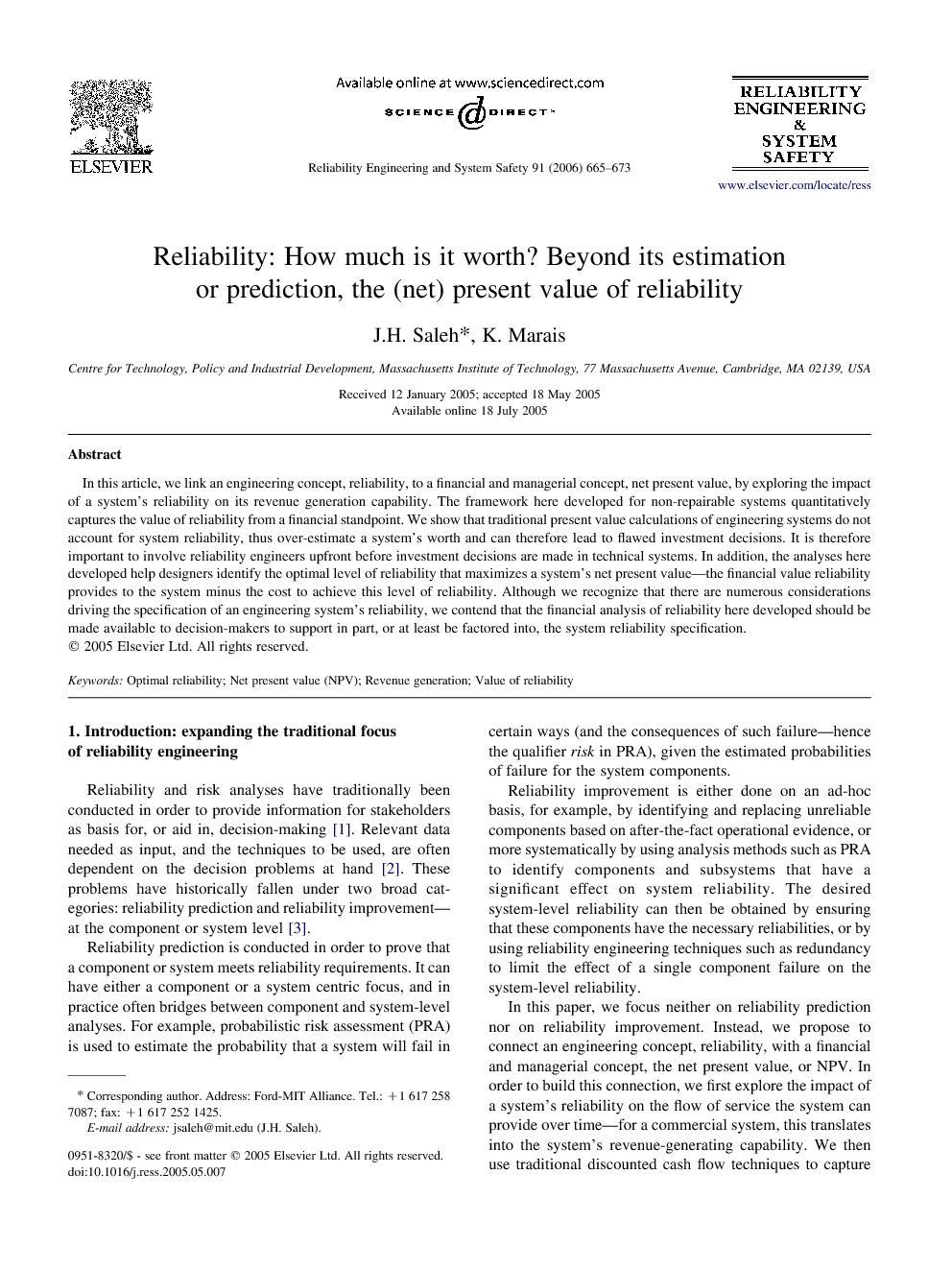In this article, we link an engineering concept, reliability, to a financial and managerial concept, net present value, by exploring the impact of a system's reliability on its revenue generation capability. The framework here developed for non-repairable systems quantitatively captures the value of reliability from a financial standpoint. We show that traditional present value calculations of engineering systems do not account for system reliability, thus over-estimate a system's worth and can therefore lead to flawed investment decisions. It is therefore important to involve reliability engineers upfront before investment decisions are made in technical systems. In addition, the analyses here developed help designers identify the optimal level of reliability that maximizes a system's net present value—the financial value reliability provides to the system minus the cost to achieve this level of reliability. Although we recognize that there are numerous considerations driving the specification of an engineering system's reliability, we contend that the financial analysis of reliability here developed should be made available to decision-makers to support in part, or at least be factored into, the system reliability specification.
Reliability and risk analyses have traditionally been conducted in order to provide information for stakeholders as basis for, or aid in, decision-making [1]. Relevant data needed as input, and the techniques to be used, are often dependent on the decision problems at hand [2]. These problems have historically fallen under two broad categories: reliability prediction and reliability improvement—at the component or system level [3].
Reliability prediction is conducted in order to prove that a component or system meets reliability requirements. It can have either a component or a system centric focus, and in practice often bridges between component and system-level analyses. For example, probabilistic risk assessment (PRA) is used to estimate the probability that a system will fail in certain ways (and the consequences of such failure—hence the qualifier risk in PRA), given the estimated probabilities of failure for the system components.
Reliability improvement is either done on an ad-hoc basis, for example, by identifying and replacing unreliable components based on after-the-fact operational evidence, or more systematically by using analysis methods such as PRA to identify components and subsystems that have a significant effect on system reliability. The desired system-level reliability can then be obtained by ensuring that these components have the necessary reliabilities, or by using reliability engineering techniques such as redundancy to limit the effect of a single component failure on the system-level reliability.
In this paper, we focus neither on reliability prediction nor on reliability improvement. Instead, we propose to connect an engineering concept, reliability, with a financial and managerial concept, the net present value, or NPV. In order to build this connection, we first explore the impact of a system's reliability on the flow of service the system can provide over time—for a commercial system, this translates into the system's revenue-generating capability. We then use traditional discounted cash flow techniques to capture the impact of the system reliability on its financial worth, or NPV. For simplification, we call the results of our calculations the ‘value of reliability’.
The analyses we develop in this paper allow designers, in part, to identify ‘optimal’ levels of reliability for engineering systems from a financial standpoint. How is that?
Conceptually, the process for deciding how much reliability is required from a system (i.e. system reliability specification) involves on the one hand an assessment of the value of reliability—how much is it worth to the system's stakeholders—and on the other hand, and assessment of the ‘costs’ of reliability. In this work, we focus on revenue-generating systems—such as communication satellites or deep-sea cable systems—that have negligible risk of causing injury or loss of life when they are operational (questions of value of human life are very complex and sensitive, and are beyond the scope of this work). By identifying the impact of reliability of such systems on their NPV (the value of reliability minus the cost of obtaining it, hence the ‘net’ value in the NPV), the framework and analyses developed in this paper provide (financial) information for decision-makers to support in part the reliability specification requirement.
The motivation for this article is twofold: on the one hand, there is the recognition that ‘infinitely reliable’ components or system do not exist—that failure will occur but can be ‘delayed’ through improved reliability—and on the other hand, that improved reliability often requires additional resources and comes at a price. From these two observations, we acknowledge that reliability specification requires choices and trade-offs. When the requirement is not imposed by regulators (for example, based on the public's ‘acceptable’ level of risk), or by market conditions, system designers, in deciding how much reliability is needed, must assess how much reliability is worth and how much they are willing to ‘pay’ for it.
In this article, we developed a framework for non-repairable systems that quantitatively captures the value of reliability from a financial standpoint, and in effect, allow designers to identify the optimal level of reliability that maximizes a system's net present value (the financial value reliability provides to the system minus the cost to achieve this level of reliability).
We also showed that traditional present value calculations of engineering systems do not account for system reliability; they in effect implicitly assume that the system remains 100% reliable throughout its operational lifetime and thus always over-estimate a system's net value and can therefore lead to flawed investment decisions. This finding points to the need of involving reliability engineers upfront before investment decisions are made in technical systems.
Finally, in linking an engineering concept, reliability, to a financial and managerial concept, net present value, we contribute financial information to decision-makers to support in part the specification a system's reliability.


